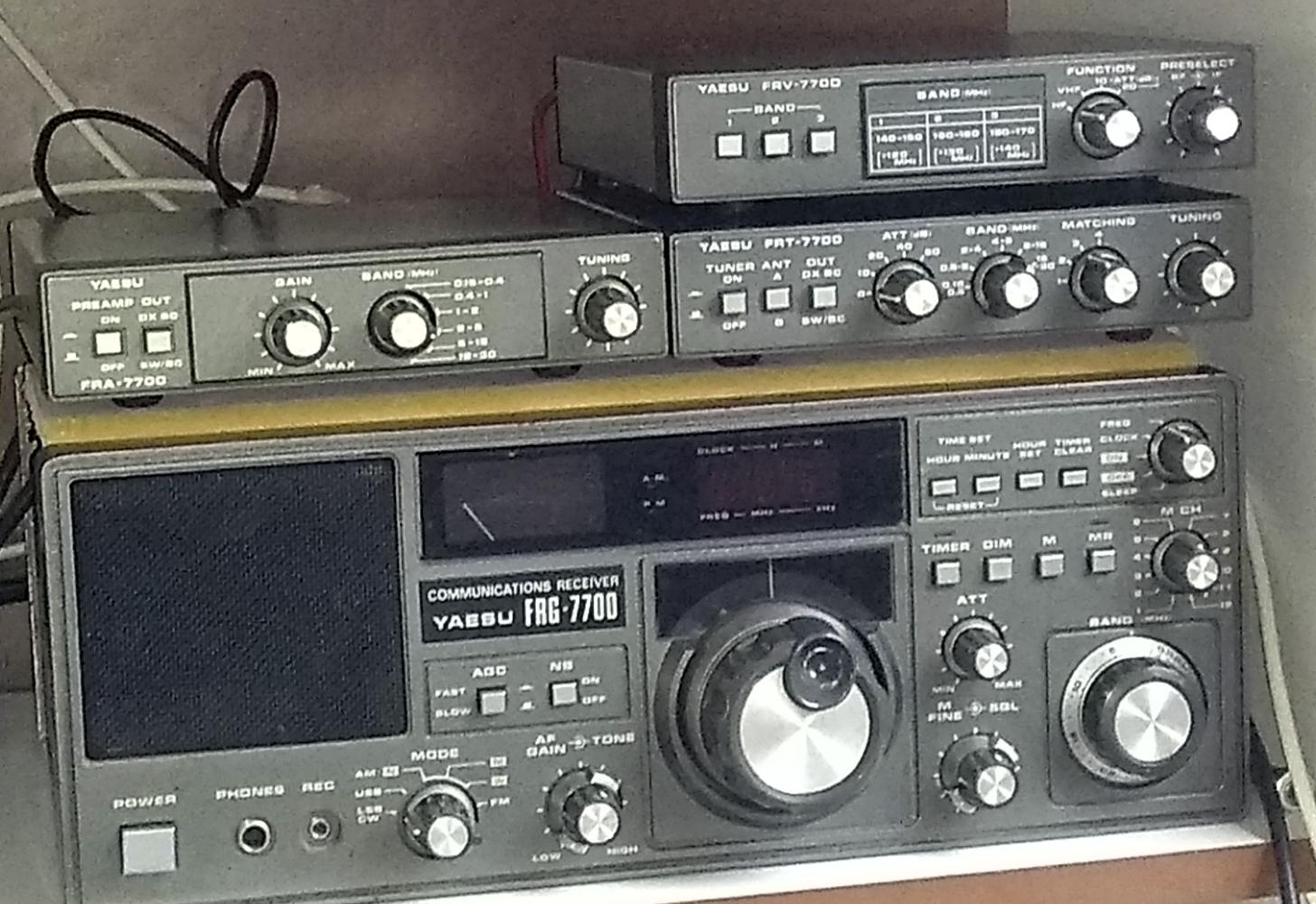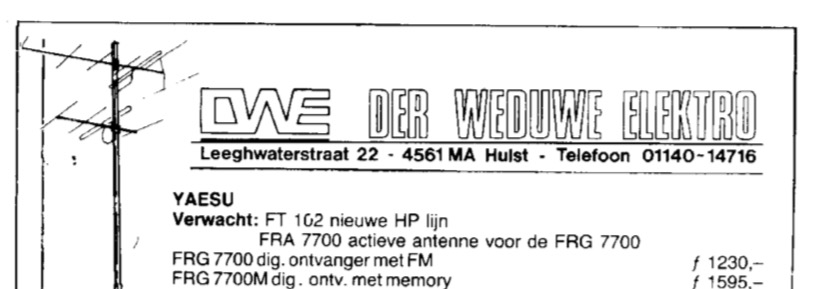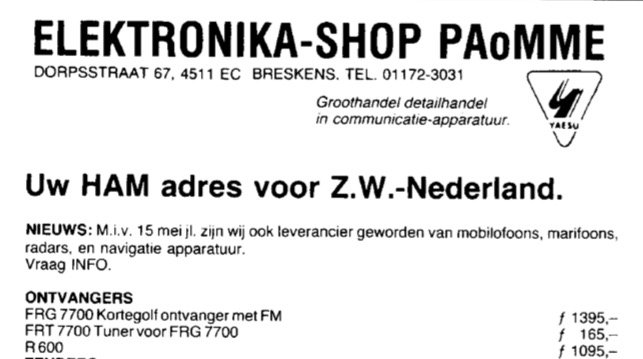
553
Item nr.

Yaesu FRG-7700 Communications receiver
Well-equipped amateur receiving station.
Data for Yaesu FRG-7700
| Production | Japan, 1982.
Price was DM1478, fl 1230 or 1595. |
|---|
| Bands | 0-30MHz (in 30 1MHz bands); IF 48055/455kHz. |
|---|
Semi-
conductors | 123 Transistors. |
|---|
| Cabinet | None (missing).
Size 33.5x13x26cm.
|
|---|
| Power | AC (OFF: 4.2W, ON: 22.4W). |
|---|
The Design
The Yaesu "Frog" FRG-7700 was produced from 1981 to 1984, and was one of the top communications receivers for amateur use. The 2F in the type numer indicate production of this unit in June 1982. It features complete coverage of the HF spectrum (0 through 30MHz) with digital frequency readout (resolution 1kHz) in modes LSB, USB, AM (3 bandwidths), and FM. It takes some days to discover all possibilities, because the four units have 40 controls together, but then it becomes a flexible and powerful listening station. How much you can hear, depends very much on the quality of your antenna, of course. The Frog has no BFO clarifier; there are two fixed BFO settings for USB and LSB, and you must clarify SSB speech by tuning the main tuning knob very precisely. This works out well most of the time, but still I'd prefer a possibility to finetune the BFO. The base station can be extended with a lot of options, of which my set has four.
 Memory Unit MU-7700. Digital presets were not commonly found in 1981, and having these was an option. Fortunately, my set has this unit. It can store and retrieve 12 frequencies. The Memory unit was quite expensive, as seen from the ad on the right. The memory consisted almost one quarter of the price of the receiver.
Memory Unit MU-7700. Digital presets were not commonly found in 1981, and having these was an option. Fortunately, my set has this unit. It can store and retrieve 12 frequencies. The Memory unit was quite expensive, as seen from the ad on the right. The memory consisted almost one quarter of the price of the receiver.
 Tuner FRT-7700. The antenna tuning unit can switch between two connected antenna's, and optimize for one specific frequency (or small range). Normally, one would switch it OFF and have the aerial signal fed directly to the receiver. But to hear weak signals in a specific narrow range, one could switch on this tuner and tune the antenna to this frequency. This degrades the aerial effectivity for other frequencies, so using is all the time would force you to tune the radio and the tuner simultaneously. A burden that can often be avoided. The Tuner unit made up for just one tenth of the installation, but still was more expensive than many portables at that time.
Tuner FRT-7700. The antenna tuning unit can switch between two connected antenna's, and optimize for one specific frequency (or small range). Normally, one would switch it OFF and have the aerial signal fed directly to the receiver. But to hear weak signals in a specific narrow range, one could switch on this tuner and tune the antenna to this frequency. This degrades the aerial effectivity for other frequencies, so using is all the time would force you to tune the radio and the tuner simultaneously. A burden that can often be avoided. The Tuner unit made up for just one tenth of the installation, but still was more expensive than many portables at that time.
Active Antenna FRA-7700. This unit has a whip antenna (1.2m) and internal pre-amplifier. That is useful where an outdoor aerial isn't possible, but I have a long outdoor antenna. So I unscrewed the whip and connected a lead for my loop antenna's.
VHF Converter FRV-7700.With this unit, the Frog can be used to listen in to frequencies in the 100 to 200 MHz range. There are six versions, and I have type C which has bands 140-150MHz, 150-160MHz, and 160-170MHz. The chosen range is found between 20 and 30 MHz on the receiver. It mixes with crystal generated signals (120, 130, and 140 MHz), which generates images of FM broadcasting stations. For example, NPO4 at 94.3MHz disturbs reception at 145.7MHz. The converter provides an additional antenna jack for a VHF antenna.
Other options (that I don't have) include an external speaker, and a larger S-meter. I set up the station with all units connected, and I can switch between my 20m longwire antenna, my loop antenna's (TelRaam and 80m loop), and use the Beer Barrel for the 2m band.
| Obtained | 7/2021
from Leo (through Transistorforum); SN=2F160492, Memory 051081, Antenna 6I240328, Tuner 7I410064, VHF Conv 2D610128. |
|---|
| Condition | 8; works , front is neat, cabinet misses, three additional units. |
|---|
| Disposed | Sold 1/2023. |
|---|
This Object
The three additional units came a bit dirty, but complete and fully working as far as I can tell. The General Coverage receiver came with a few small issues, which didn't prevent me from setting up the station and starting to use it. (1) The front of all devices is a bit dirty. (2) The FRG has no cabinet; I had to place a wood board on top to place the other three units on top. (3) The dial lamp behind the analogue kHz dial is defective. (4) There is no sound unless the Noise Blanker is switched ON. (5) The push contacts for the aerials run very stiff. (6) The digital frequency appears to indicate 1 or 2 kHz too low.In September 2021 I fixed some acrylic sheets around the chassis to replace the cabinet.
Part of Gerard's Radio Corner.
Generated by SiteBuilder on
26/2/2024
by Gerard
(g.tel@uu.nl)
 Memory Unit MU-7700. Digital presets were not commonly found in 1981, and having these was an option. Fortunately, my set has this unit. It can store and retrieve 12 frequencies. The Memory unit was quite expensive, as seen from the ad on the right. The memory consisted almost one quarter of the price of the receiver.
Memory Unit MU-7700. Digital presets were not commonly found in 1981, and having these was an option. Fortunately, my set has this unit. It can store and retrieve 12 frequencies. The Memory unit was quite expensive, as seen from the ad on the right. The memory consisted almost one quarter of the price of the receiver.

 Tuner FRT-7700. The antenna tuning unit can switch between two connected antenna's, and optimize for one specific frequency (or small range). Normally, one would switch it OFF and have the aerial signal fed directly to the receiver. But to hear weak signals in a specific narrow range, one could switch on this tuner and tune the antenna to this frequency. This degrades the aerial effectivity for other frequencies, so using is all the time would force you to tune the radio and the tuner simultaneously. A burden that can often be avoided. The Tuner unit made up for just one tenth of the installation, but still was more expensive than many portables at that time.
Tuner FRT-7700. The antenna tuning unit can switch between two connected antenna's, and optimize for one specific frequency (or small range). Normally, one would switch it OFF and have the aerial signal fed directly to the receiver. But to hear weak signals in a specific narrow range, one could switch on this tuner and tune the antenna to this frequency. This degrades the aerial effectivity for other frequencies, so using is all the time would force you to tune the radio and the tuner simultaneously. A burden that can often be avoided. The Tuner unit made up for just one tenth of the installation, but still was more expensive than many portables at that time.